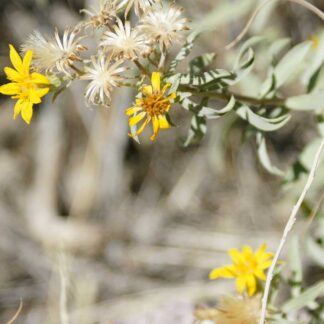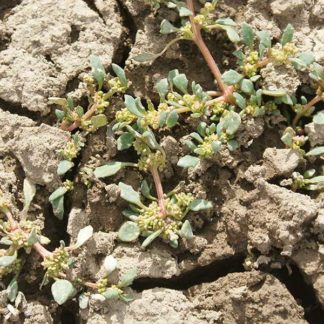all the time
Showing 1–12 of 19 results
-

Beteroa incana / hoary alyssum
- dense clusters of teeny white flowers
- 4 petals, each with a notch
- fruit is a short, fat-ish seed pod (silicle)
- found in pastures and all manner of disturbed habitats
- toxic to horses
-

Blitum nuttallianum / Nuttall’s povertyweed
- ugly little creeping plant from a central stem
- arrow-shaped leaves with two prominent lobes, especially on lower leaves
- teeny clusters of teeny greenish flowers; no petals; in most leaf axils
- widespread, but usually exposed and weed-like
-

Capsella bursa-pastoris / shepherd’s purse
- small crucifer with terminal clusters of teeny white flowers
- rosette of small, maybe toothed, leaves
- very distinctive, notched, triangular fruits - like shepherd's "purses"
- found pretty much anywhere that has/had bare soil
-

Cardamine hirsute / hairy bittercress
- small brassica/crucifer with compound leaves
- teeny white, 4 petal flowers with 4 stamens in racemic clumps
- a widespread weed, including gardens and lawns
-

Castilleja miniata / scarlet paintbrush
- bright red, or orange or sometimes yellow bracts that are mistaken for flowers
- looks like a red feather duster, but only a few inches long
- generally low, and along streams or roadsides on hills where there is moisture
- leaves ovoid with prominent veins, no petioles
-

Equisetum hyemale / rough horsetail
- thin green stems with black bands; no branches
- possible cone-like structure at the apex
- usually in large colonies
- prefers continuously moist soils
-

Heterotheca villosa / hairy goldenaster
- yellow composite with 10-20 ray florets, orange-brown disk
- hairy leaves and stems
- blooms throughout season, often densely
- disturbed and challenging habitats
-

Malva neglecta / cheeseweed
- leaves look like grocery store geraniums (Pelargonium)
- flowers are small, pink-ish and often buried in the foliage
- fruits are small (ca. 1/2 in) and round
-

Oxybasis glauca / oak-leaved goosefoot
- typically prostrate and small, apart from other plants
- mudflats and other drying wet areas
- small, blue-green, small-lobed leaves; often w/ reddish stems
- teeny clusters of teeny yellow flowers
- leaves feel cool and damp due to glandular hairs on lower surface
-

Phleum pratense / timothy
- tight, cylindrical flower head
- probably the most recognizable grass in the Valley
- pink stamens with prodigious pollen production in summer
- bulb at base of stem; brown leaf sheath bases
-

Plantago major / broadleaf plantain
-

Polemonium occidentale / western Jacob’s ladder
- brilliantly blue flowers with bright yellow anthers, in clusters
- pinnately compound leaves with up to 27 narrow, lance-shaped leaflets
- most leaves on separate stems from the flowers
- usually in wetlands
Showing 1–12 of 19 results